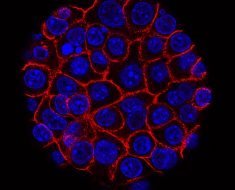In the ongoing quest for a successful treatment for Alzheimer’s disease, a team of scientists from several leading research institutions have created a map of the molecular network in the aging brain. Molecular networks are cellular and subcellular structures in an organism and the structures’ physical interaction between molecules, RNA, or proteins.
The researchers used their map to identify two new Alzheimer’s disease target genes—that is, genes that can be deleted, added, or modified, in the ongoing quest for a successful treatment for the disease. The team presented their findings in a paper published in Nature Neuroscience on May 25.
Led by principal investigators Dr. David A. Bennett at Rush University Medical Center in Chicago and Dr. Philip L. De Jager at Columbia University in New York, the research team is part of the Accelerating Medicines Program for Alzheimer’s disease. Known as the AMP-AD, the program seeks to leverage advances in analytic methods and large-scale molecular profiles of the aging brain to identify novel therapeutic targets for Alzheimer’s disease.
The National Institute on Aging and the Foundation for the National Institutes of Health spearheaded the development of AMP-AD in collaboration with several industry and non-profit partners. The program launched in 2013.
Map distinguishes between events leading to brain pathology and to loss of cognitive function
The network described in the Nature Neuroscience manuscript accounts for all older people, not just those that meet certain diagnostic guidelines. Further, it separates molecular events that lead to changes in brain tissue (pathology) from those involved in loss of cognitive function, which is the true target of therapeutic efforts.
“Prior network approaches had not considered the detailed change in cognitive state over time of older individuals,” said Bennett. “Instead, they had relied on comparisons of cases from a dementia clinic with volunteers who after their deaths came to autopsy without ever developing dementia. This does not capture the variability over time exhibited by a diverse population of older individuals.”
The burden of Alzheimer’s disease on our aging human populations is growing rapidly, but current therapeutic strategies targeting a small number of proteins have yet to yield a successful treatment.
Analysis honed in on genes most likely to drive cognitive decline
The study drew on data about the deeply characterized subjects from two community-based studies based at the Rush Alzheimer Disease Center. Participants in these studies receive extensive medical testing and evaluation while alive and donate their brains to research upon their deaths. None of the participants had a diagnosis of dementia when they enrolled in the study, but some later developed it.
The investigators have created a unique resource that links molecular changes in nearly 500 older brains profiled in this study to both the individual trajectories of participants’ change in cognition over multiple years prior to death and detailed measures of Alzheimer’s disease and other common brain pathologies measured after death. “We have a detailed picture of brain function before death and an extensive evaluation of the molecular features of each individual brain,” De Jager observed.
Co-lead author Chris Gaiteri, Ph.D., also from the Rush Alzheimer’s Disease Center, added that “unlike traditional studies, all possible outcomes and molecular events are considered simultaneously, enabling us to prioritize a few large groups of genes that are most likely to lead directly to cognitive decline and/or brain pathology, instead of having to focus on a large list of individual genes.”
His co-lead author, Sara Mostafavi, Ph.D., of the University of British Columbia, extended this comment, “The strength of our analytic approach is that it makes no assumptions as far as what genes are important,” she said.
“While we find thousands of genes associated with cognitive decline, we do not simply go for the strongest gene. We find patterns that lead to cognitive decline and then prioritize a small subset of genes that appear to be driving these large-scale changes.”
Experiment reduced genes’ production of protein that contributes to Alzheimer’s
These so called “driver genes” are potentially excellent candidates or targets for developing Alzheimer’s disease therapies. However, statistical analyses are not enough.
Therefore co-investigator Tracy Young-Pearse, Ph.D., from Brigham and Women’s Hospital designed an experiment in which some of these target genes were perturbed to see if this change affected known molecules involved in Alzheimer’s disease.
“When they were altered in human astrocytes, a type of brain cell that plays a key role in maintaining brain function, two of the 14 genes predicted to be driver genes by the network displayed a reduction in the secretion of amyloid beta, a protein that contributes to the onset of Alzheimer’s disease,” Young-Pearse said. These two genes make proteins and the approach raises the possibility that finding drugs that affect those proteins could also lower the production of amyloid beta. Dr. Bennett and his colleagues recently measured a number of the proteins in the network to see if they could replicate the predictions from the network map.
Using the network to predict the 14 driver genes itself was a scientific feat akin to finding the proverbial needle in a haystack, given that the brain map includes about 14,000 genes.
“This study is a milestone in the study of Alzheimer’s disease and the aging brain, said De Jager. “We established a molecular network that not only predicts Alzheimer’s disease genes that can be validated experimentally but also can be repurposed to study very different molecular events involved in brain aging, such as stroke, and the fundamental function of the brain itself.”
Sharing science to spur discoveries
All data and network models were made available to share with the scientific community via the AMP-AD Knowledge Portal and the Rush Alzheimer’s Disease Center Resource Sharing Hub before the publication of the manuscript to enable other investigators to make us of the data and underlying observations for their own studies and to allow them to confirm the results of the study independently.
“This study is the culmination of efforts by the NIA, multiple pharmaceutical industry partners, and a tight-knit group of academic investigators to provide a novel, unbiased perspective on Alzheimer’s disease biology,” said Bennett. “Importantly, this approach does not focus on a single gene of interest, but rather searches for the key nodal point in a network where an intervention may be most likely to have an effect on a devastating disease that remains untreated today.”
Source: Read Full Article





